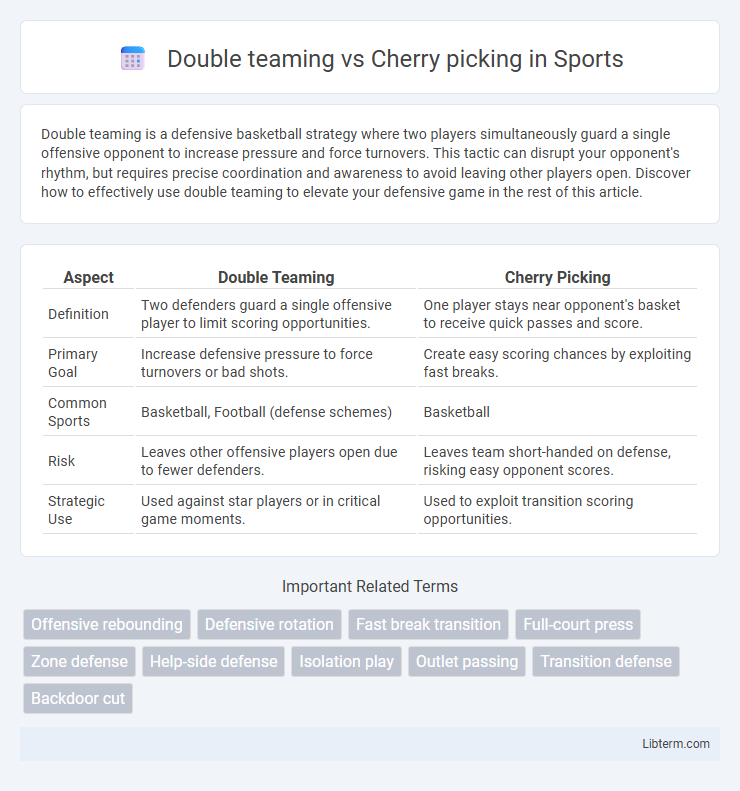Double teaming is a defensive basketball strategy where two players simultaneously guard a single offensive opponent to increase pressure and force turnovers. This tactic can disrupt your opponent's rhythm, but requires precise coordination and awareness to avoid leaving other players open. Discover how to effectively use double teaming to elevate your defensive game in the rest of this article.
Table of Comparison
| Aspect | Double Teaming | Cherry Picking |
|---|---|---|
| Definition | Two defenders guard a single offensive player to limit scoring opportunities. | One player stays near opponent's basket to receive quick passes and score. |
| Primary Goal | Increase defensive pressure to force turnovers or bad shots. | Create easy scoring chances by exploiting fast breaks. |
| Common Sports | Basketball, Football (defense schemes) | Basketball |
| Risk | Leaves other offensive players open due to fewer defenders. | Leaves team short-handed on defense, risking easy opponent scores. |
| Strategic Use | Used against star players or in critical game moments. | Used to exploit transition scoring opportunities. |
Understanding Double Teaming in Basketball
Double teaming in basketball is a defensive strategy where two defenders simultaneously guard a single offensive player to limit their scoring opportunities and force turnovers. This tactic is especially effective against high-scoring opponents or key playmakers, disrupting their rhythm and passing options. Understanding double teaming requires recognizing when to help teammates while maintaining overall team defensive balance to prevent easy shots from other players.
Cherry Picking: Definition and Tactics
Cherry picking in basketball refers to a strategy where a player stays near the opponent's basket instead of playing defense, aiming to quickly receive a pass and score an uncontested layup or dunk. This tactic exploits defensive mismatches and creates fast-break opportunities by bypassing the traditional transition defense. Effective cherry picking requires precise timing, court awareness, and communication with teammates to capitalize on scoring chances while minimizing defensive vulnerabilities.
Strategic Purposes of Double Teaming
Double teaming in basketball serves the strategic purpose of applying intense defensive pressure on a key offensive player, forcing turnovers and disrupting scoring opportunities. It concentrates defensive resources to exploit an opponent's reliance on a star player, thereby reducing their offensive efficiency. Unlike cherry picking, which focuses on quick scoring opportunities off missed shots, double teaming prioritizes controlling the defensive half to limit high-percentage plays.
Benefits and Risks of Cherry Picking
Cherry picking in basketball allows a player to quickly score by staying near the opponent's basket, creating fast-break opportunities and easy points that can shift momentum. However, it poses risks such as leaving the team vulnerable to defensive turnovers, resulting in easy baskets for the opposing team due to reduced player presence in the defensive half. While effective for rapid scoring, cherry picking demands exceptional team coordination and awareness to mitigate defensive weaknesses and maintain overall team balance.
Defensive Impact: How Double Teaming Disrupts Offense
Double teaming forces offensive players to make quicker, less accurate decisions by increasing defensive pressure on key scorers, effectively disrupting ball movement and shot selection. This tactic reduces the offensive player's space and time, leading to turnovers or forced passes that weaken offensive rhythm. In contrast, cherry picking risks defensive vacancies, potentially allowing easy scoring opportunities despite offensive disruption.
Offensive Opportunities with Cherry Picking
Cherry picking in basketball creates significant offensive opportunities by enabling quick transitions and easy scoring chances before the defense can set up. Players positioned near the opponent's basket can capitalize on missed shots or turnovers to score uncontested points, increasing the team's scoring efficiency. This strategy contrasts with double teaming, which prioritizes defensive pressure but risks leaving parts of the court open for swift offensive plays.
Key Differences Between Double Teaming and Cherry Picking
Double teaming involves two defensive players simultaneously guarding a single offensive player to limit their effectiveness and force turnovers, while cherry picking is an offensive strategy where a player stays near the opponent's basket to capitalize on fast breaks and easy scoring opportunities. Double teaming prioritizes defensive pressure and disruption, whereas cherry picking focuses on offensive positioning and opportunistic scoring. The effectiveness of double teaming depends on defensive coordination, while cherry picking relies on speed and timing to exploit defensive lapses.
Situational Usage: When to Double Team or Cherry Pick
Double teaming is most effective in high-pressure defensive situations, such as during critical possessions or when guarding a dominant scorer to force turnovers and disrupt offensive flow. Cherry picking is strategically used when a team wants to exploit fast-break opportunities by leaving a player near the opponent's basket for quick scoring chances, often after a defensive rebound or steal. Coaches decide based on game tempo, player stamina, and opponent tendencies, balancing defensive risk with potential offensive reward.
Famous Examples in Basketball History
Double teaming, a defensive strategy where two players guard a single opponent, is famously exemplified by the 1990s Chicago Bulls, who often double teamed Michael Jordan to disrupt his scoring rhythm. Cherry picking, an offensive tactic where a player stays near the opponent's basket to receive long passes, was notably used by Pete Maravich, whose exceptional passing skills made this riskier strategy effective. These contrasting approaches highlight the strategic diversity in basketball, with double teaming focused on containment and cherry picking aimed at quick scoring opportunities.
Choosing the Right Strategy for Your Team
Double teaming maximizes defensive pressure by assigning two defenders to a key opponent, disrupting their rhythm and forcing turnovers, making it ideal against dominant scorers. Cherry picking relies on leaving a player near the opponent's basket to capitalize on fast-break opportunities, effective when your team excels in speed and transition offense. Selecting the right strategy depends on your team's defensive strengths and tempo, balancing aggressive containment with exploiting scoring chances.
Double teaming Infographic

 libterm.com
libterm.com